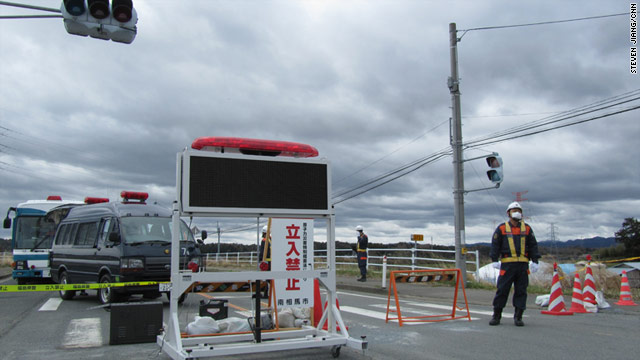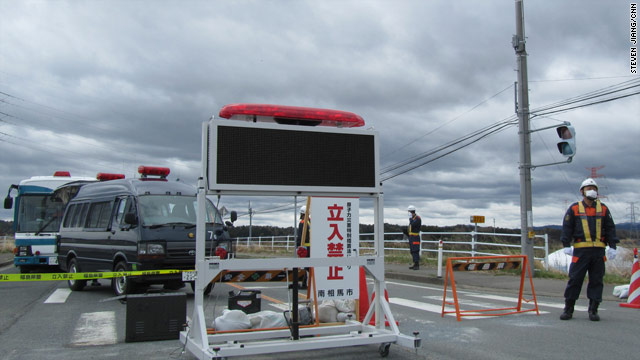Stricter enforcement of nuclear evacuation zone to begin
April 21, 2011 -- Updated 0726 GMT (1526 HKT)

Police guard a checkpoint in Minamisoma, Japan, just outside the 20km exclusion zone.
STORY HIGHLIGHTS
- Evacuation order covers zone within 20-kilometers of the nuclear plant
- Enforcement has been uneven from checkpoint to checkpoint
- "I wish I could trust the government, but I can't," an evacuee tells CNN
- A government official says the crackdown is needed for public safety
The restriction --in place since the early days of the nuclear disaster -- has often been ignored.
Many of the about 78,000 people who have homes in the evacuation zone have gone back in recent weeks to retrieve belongings, and check on farms and businesses.
No one will be allowed within 3 kilometers of the crippled nuclear facility and entry within 20 kilometers of the plant will be highly regulated, Chief Cabinet Secretary Yukio Edano told reporters Thursday.
People who temporarily return to their homes, businesses and farms must wear a protective suit and ride into the restricted zone on a designated bus.
 Gallery: Inside Japan's nuclear zone
Gallery: Inside Japan's nuclear zone  Fukushima Exclusion Zone tour
Fukushima Exclusion Zone tour  Sharing experiences of disaster
Sharing experiences of disaster RELATED TOPICS
The stricter enforcement within the zone is necessary "to guarantee the health and safety of the people," Edano said previously, noting that Tokyo will work with local officials in closing the zone.
Edano said the government plans to designate the area an "alert zone" under Japanese laws governing disaster response, a move he said would give authorities the power to crack down on people going into and out of the evacuated area.
Police are currently stationed at checkpoints leading into the area, but enforcement appears to vary from post to post or officer to officer.
A CNN crew entered the area for a short time Wednesday and encountered a young farmer whose family lives just inside the 20-km (12.5-mile) boundary. He said his father was considering returning home -- but as a young, unmarried man, he was considering quitting the farm his family has worked for three generations.
"I'm concerned about the impact on my health," said the farmer, who declined to be named. "I wish I could trust the government, but I can't."
The disaster, now the worst nuclear accident since Chernobyl, occurred when the Fukushima Daiichi plant was struck by the March 11 tsunami that devastated northern Japan, knocking out its coolant systems and causing its three operating reactors to overheat.
The plant's operator, Tokyo Electric Power Co., said Thursday that a meltdown could be taking place at the troubled facility, but also acknowledged that there's no way to know for sure.
TEPCO told CNN that it cannot say that the nuclear fuel rods at the three reactors have never melted or that they are not melting right now, nor can the company say for certain that the rods have melted or are melting now.
The Japanese government says it has no detailed readings of radiation levels inside the 20-km zone. But journalists who have entered the areas have recorded radiation levels that typically range around a few thousandths of a millisieverts per hour. By comparison, a typical resident of an industrialized country receives about 3 millisieverts per year.
One reporter who came within 2 kilometers of the power plant in early April recorded a dose of about a tenth of a millisievert per hour -- high enough to increase the long-term risk of cancer with prolonged exposure, but a tiny fraction of the dose that would induce radiation sickness.Fonte CNN




0 comentários:
Postar um comentário